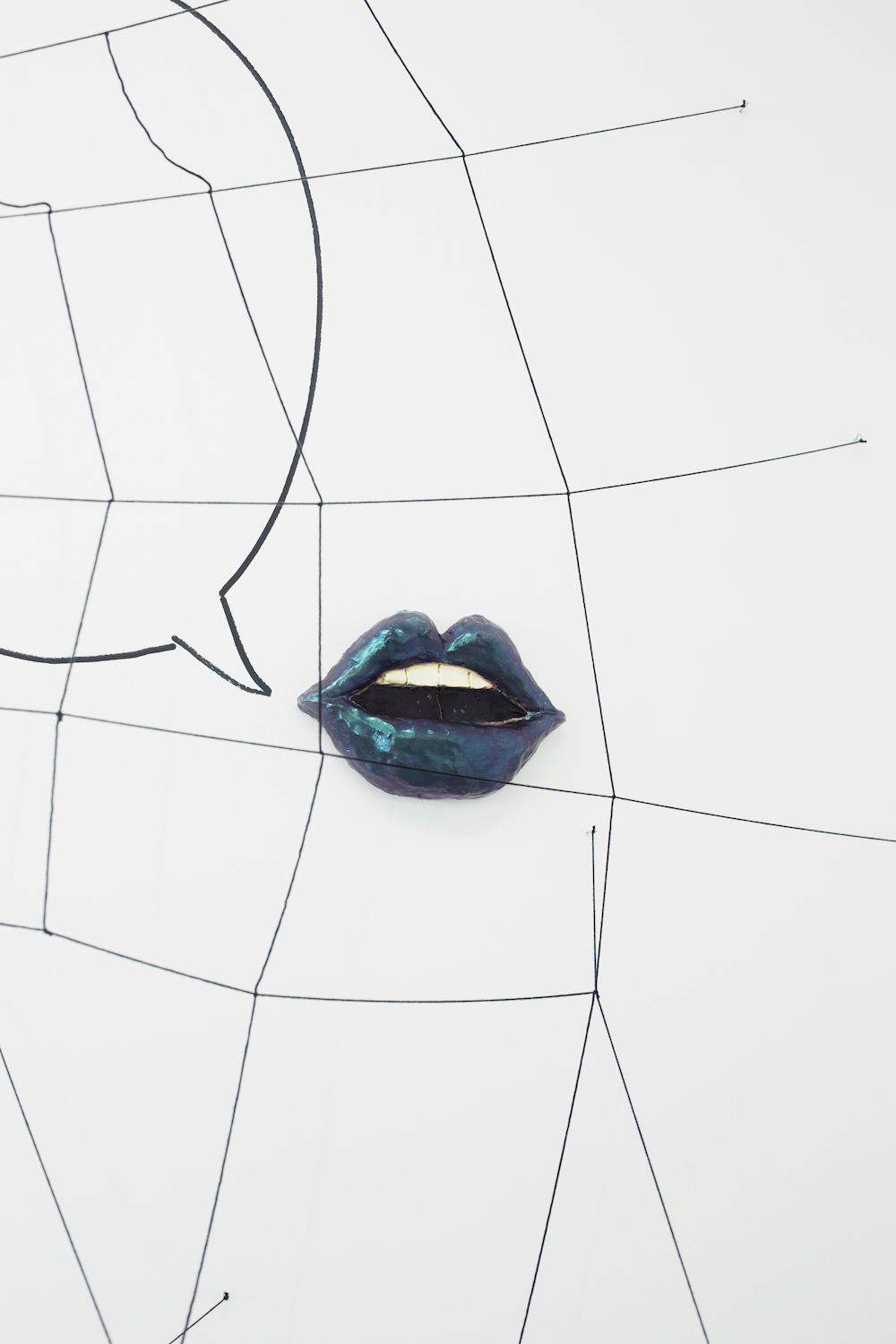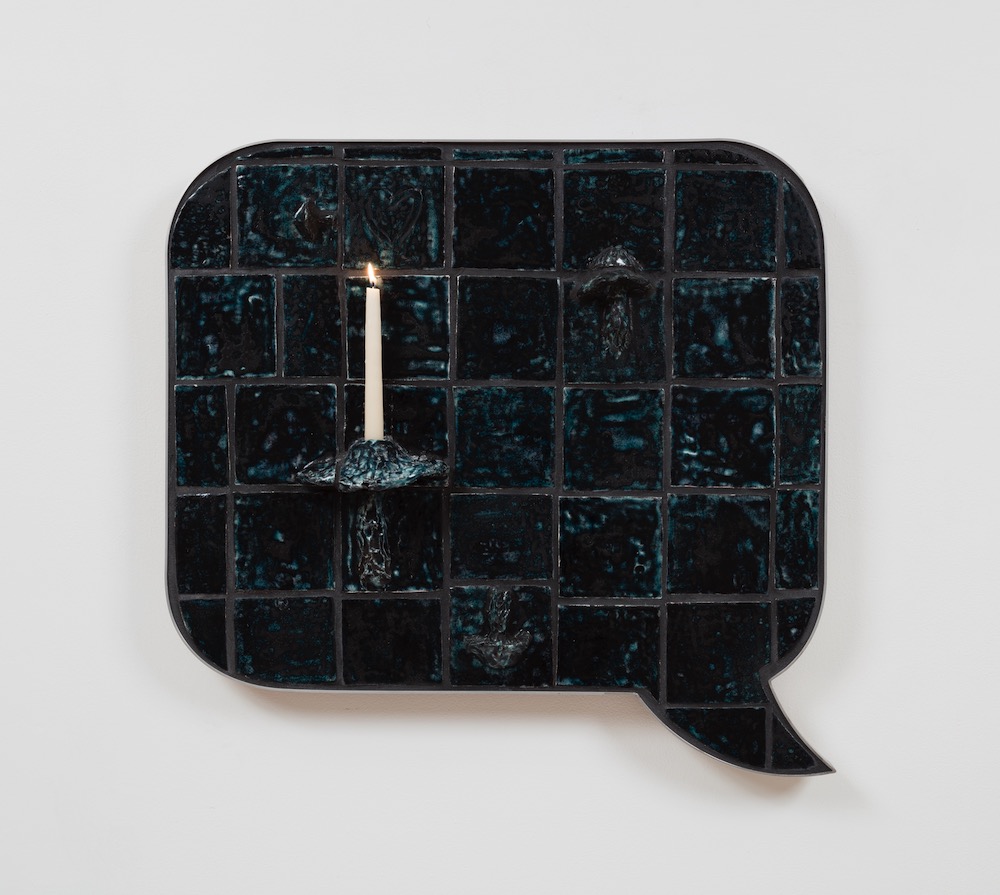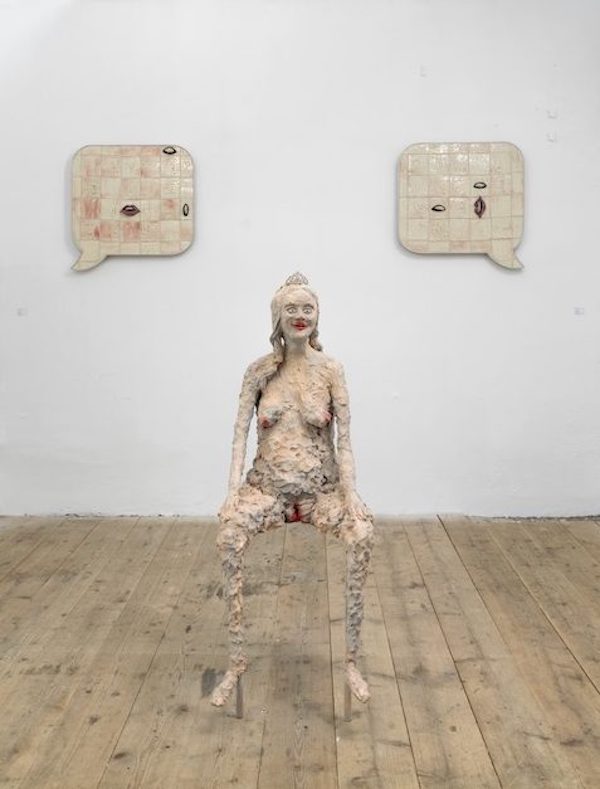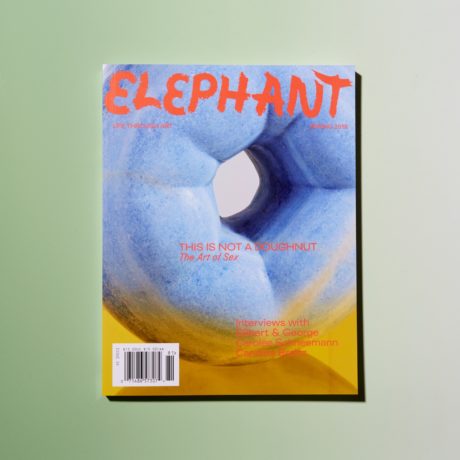
Having moved to Berlin in 2016 Liz Craft has already relocated again, this time moving back to America to settle in New York. Arguably, this frenetic movement is reflected in her artworks, as she sculpts wild and energetic forms which inevitably delight viewers. Her hallucinogenic characters have included clowns, mermaids, unicorns, the Three Graces and wide-eyed Siamese twins; it’s easy to imagine how you might encounter some of these on a trip to another dimension, they’re certainly not of this planet.
When I enter the artist’s Berlin-based ceramics studio in the summer of 2017—which she has temporarily borrowed—she has just removed some new works from the kiln which are still hot to the touch; there’s a green frog head with a wide-open mouth, and ceramic tiles upon which pursed lips and vaginas had been sculpted. Given that she is just about to up and leave, I wonder why Craft came to Berlin in the first place, or indeed, why she is about to go again—Berlin is renowned for luring artists into its fold, with cheap studios (though now less so), wild night life and a fantastic ecology of galleries, museums, writers, curators and so on. “Pentti [Monkkonen, Liz’s partner] and I had done a few residencies in Europe and we wanted to move here,” she tells me, “but it took fifteen years to actually do it. We came to Berlin in the summer of 2014. Then we decided we had to come back, so here we are.”

“I’ve always been interested in materials, and using them in whichever way I want”
Now back in Los Angeles, Craft’s life is deeply embedded in the city’s art scene, where she previously ran a gallery with Monkkonen called Paradise Garage, exhibiting artists including Oscar Tuazon, Jonas Lipps, Yulan Grant and Natalie Jones. Why, as an artist, had she also wanted to programme her own space? “We started to get tired of LA and we went to New York in 2011, but we didn’t have the money to stay so went back to LA. That’s what made us start the project space in 2012. It was hard but really good.”
“We thought, ‘Okay, if we’re going to live in LA we have to bring people to us.’ If you live in New York it’s much more fluid and you can see people. But in LA, even within the city, it’s hard to go across town because of the driving—it’s insane. So we thought, ‘Let’s just try and get into it here in LA and try to make something interesting.’ We showed people what we like, brought people to town, and that led to starting Paramount Ranch—because then Europeans came and it was a fun scene.”
Paramount Ranch was an art fair that Craft and Monkkonen established with Alex Friedman and Robbie Fitzpatrick of the Los Angeles-based gallery Friedman Fitzpatrick, mounted in a former wild-west stage-set located on the outskirts of the city. “We met Friedman Fitzpatrick through mutual friends. They had also wanted to start a fair and were interested in similar things. They had just lived in Berlin so it was perfect because they knew everybody and we could bring in the LA part. So it worked out; it was nice. It was a fair, but not really. We invited galleries but it wasn’t so commercial. We made it cheap, so it didn’t really matter if people sold stuff.”
I wonder if it was meeting Friedman Fitzpatrick that had further encouraged Craft and Monkkonen to make the move to Berlin, given that these gallerists had actually met while living in the city? “It opened the window because then we met people from Berlin at Paramount Ranch. I was casually talking to Stefania from Supportico Lopez and I said: ‘We really want to come to Europe.’ She said: ‘Well, we really want to come to LA.’ So we did an exchange. Three summers ago we took their gallery and they took ours. And we saw how fun it was in Berlin (granted it was summer!). It has a great art scene and it’s still cheap.”

Born in Los Angeles, Craft attended Otis College of Art and Design in 1992 and later the University of California in 1997, experimenting with media that would not typically be connected: papier mâché, wool, bronze, fabric, stainless steel, clay and so on. I initially came across Craft’s practice while conducting research as project editor for Phaidon’s recent publication Vitamin C: Clay + Ceramic in Contemporary Art, falling in love with the artist’s style and humour, which carries through in her sculpture.
Of her approach to using mixed media, working across the traditional divide of high and low culture, Craft speaks of how: “I’ve always been interested in materials, and using them in whichever way I want. It’s probably one of the strongest things I do, or maybe the most ‘figured out’.” And what of her approach to blurring the boundaries of the fine art-craft hierarchy? “I think artists have been doing this for a long time; maybe it comes and goes. I get ideas from what’s around, and from things I see or remember. It’s like collaging: picking from different places and then rearranging them. Then it has a new life. It doesn’t totally matter where it came from. As long as it makes some sort of sense once it’s put together.”
It was during a 2002 residency in Guadalajara, Mexico, that Craft began to expand her engagement with clay in particular, making floor tiles which became the seed for her recent tile speech-bubble works such as Web Bubble 11 (2016), a silver wall-mounted form reminiscent of a metallic spider’s web. These evoke smartphone message bubbles and emoticons, shifting the electronic into the physical. For Craft, clay “has a place in the world—tile walls and floors. I can have that connection and then let it slip into a more imaginary space.” The oscillation that we encounter daily, moving our attention between the immaterial digital realm and that of the flesh, is the space that Craft seems to highlight, one that epitomizes our current ontology.

“With the bubbles I like the combination of heavy materiality with this graphic shape. I had made these other figures before, these hairy guys who were like blank figurative shapes with a lot of texture. And some of those had a cartoon flat word bubble coming from them. They are actually separate things but they can work together, they were bronze and stained glass. And then the sculpting was really textured. I like trying to put these things together that you wouldn’t normally. In a way the bubbles are doing the same thing, putting together these graphic texting bubbles with this more real life, physical, three-dimensional part. They don’t totally go together and I like that. I also think of them in terms of sculpture as drawing; it’s my version of a drawing.”
Craft’s representations of women are almost otherworldly, characters that cannot be pinned down or easily defined. “I think these women are usually from real life,” she tells me. “The marionette [Wendy & Lisa, 2016] has a certain style just because of the person it was modelled from (Eleonora Meoni). I wanted a person with attitude and she was perfect. When I did Me Princess, I just sculpted it and later it reminded me of one of my grandmothers, who was a queen until the end. She looks like a person who is starting to lose their mind, but is still present at the same time, who doesn’t give damn.”
“Just because you’re an old lady, it doesn’t mean you’re blank or invisible. It’s just the way people are stereotyped in movies and the media”

Me Princess (2016) was exhibited in the booth of Real Fine Arts at the Basel-based art fair, Liste. It’s a cartoonish sculpture, depicting a goggle-eyed nude female, her hair neatly scooped to the side and secured with a tiara, while squatting down open-legged. Modelled in clay and later cast in bronze, it is somewhat discombobulating and appears as a fired terracotta ceramic, having been spray-painted all over with a light pink hue, of which Craft says, “I wasn’t really thinking ‘I want to trick people.’ It just looked good!”
The skin of Me Princess appears rough, dimpled and handled, with candy-coloured rouge messily highlighting her nipples, lips and vulva. I ask Craft if the sculpture is trying to cling to her sexuality in some way: “Yes that’s true. I mean just because you’re an old lady, it doesn’t mean you’re blank or invisible. It’s just the way people are stereotyped in movies and the media. If you are going about real life it’s not like that. It’s a learned thing. I don’t think it’s reality. People get trained to think that way.”
Indeed, it’s the failing of the media and their modes of representation that have undermined the reality of what women look like, resulting in the perception of women becoming skewed. If we look at something for long enough, while it might not become truth, it becomes normalized, accepted and, as such, dangerously misleading and pressurizing for mere mortals who cannot achieve these standards of physicality. Craft’s princess could be any wannabe (or otherwise) Hollywood actress struggling to hold her smile for the cameras while vulnerable, exposed and reduced to her sexual appeal.
This feature originally appeared in issue 34
BUY ISSUE 34




